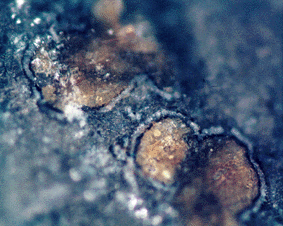Further Scrutiny of the Mars Rock
Surely more evidence can be obtained to help our decision between
whether the previous findings are biological or not!
Formation Temperature of the Carbonates
Scientists are trying to find out the temperature at which
the carbonates formed. If its really high (100s C), it would
rule out a biological origin for the fossils. A few methods
have been used, and one, looking at the fractional abundance
of different isotopes of Oxygen in the carbonate, indicates
temperatures of between 0 and 80 C! However, there are some
problems with this interpretation. Carbon isotopes do not
 agree with Oxygen isotopes and its possible the isotope ratio
may have been arrived at through escape into the air. Moreover, we don't know
the original isotope ratio to check. Because a (strong!)
magnetic field alignment is detected in
the carbonates, this suggests the T < 300 C, since the
carbonates formed. (See here).
agree with Oxygen isotopes and its possible the isotope ratio
may have been arrived at through escape into the air. Moreover, we don't know
the original isotope ratio to check. Because a (strong!)
magnetic field alignment is detected in
the carbonates, this suggests the T < 300 C, since the
carbonates formed. (See here).
What about the PAHs?
Martian PAHs are not formed the same way as (asteroid) meteoritic PAHs.
In particular, it's unlikely that PAHs could have been placed into
the rock long after its crystallization, they must have formed
there. But that doesn't mean it has to be biological. They may
have formed from inorganic processes involving chemical reactions
between pre-existing organic molecules. No matter the origin of
the PAHs, their presence tells us organic molecules do (did)
exist on Mars, which is important for living organisms. (Recall
the Viking mission found a disturbing ABSENCE of these).
Are those really Fossil Bacteria?
Perhaps the most fatal characteristic is their small size. Being
a few 10's of nm in length, if they used a cell wall
like those on earth (5-10 nm in width), there wouldn't be
room for the organism to contain anything! Maybe Martian
organisms had a very different cell wall? The fossils are
large enough to contain sufficient RNA, and are comparable in
size to terrestrial viruses and Nanobacteria
(but also see here). The simplest terrestrial life
found is still amazingly complex. Maybe Martian bacteria
are similar to the earlier, simpler phase of terrestrial
evolution we have yet to find?
An even more technical discussion is found Here